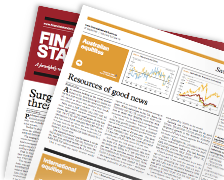If climate change is a military threat, it's an investment threatBY OSKAH DUNNIN | THURSDAY, 21 OCT 2021 6:37PMThe November COP26 United Nations climate change conference deadline has prompted many financial institutions to declare their net-zero commitments. But in case any of these new-found climate converts are wondering if climate change will really impact their investment portfolios, they should look to why climate change is worrying global military planners. For them, climate change isn't a public relations exercise they can solve by just buying a few carbon credit abatement units. It's a hard-edge life and death decision matrix they must actively prepare for. As a result, if what the world's leading militaries are discovering is a portend to how climate change will impact real-world economies, financial institutions might be wise to consider how these risks will impact their investment portfolios. Since 2019, America, the United Kingdom, France, the North Atlantic Treaty Organisation (NATO), and New Zealand have all published reports explaining how they expect climate change will impact their strategies, operational capacity and combat readiness. These reports reveal remarkable insight about climate change at a practical level: its impact on logistical planning, training, force structures and the equipment they will need. For example, troops will need new lightweight boots that won't melt in extreme heat and yet will be robust enough to keep alive the soldiers who wear them. These soldiers will need rifles that can fire in hotter deserts and wetter jungles. More intense weather events like dust storms will require longer runways for combat aircraft. Expensive American stealth bomber fleets that provide Australia's nuclear deterrence are going to become more complex to maintain. Their refrigerated hangars are set to -2 degrees Celsius to keep onboard computer systems functioning. These hangars will need to work overtime and they'll be needed in more places. Warming oceans are saltier oceans. Military experts are right now planning on their naval vessels needing much more maintenance because they will corrode faster and more severely. As access to water and traditional fuels decrease, militaries will need to protect longer, more exposed supply lines. Rougher seas along some of these transport routes will put ships in more dangerous waters for longer, impeding flight operations and extending transit times. It's a sad fact that in both the Afghanistan and Iraq wars, most American troops who died weren't killed in regular combat, they lost their lives protecting resource convoys. The workhorses of military transport, while more sophisticated, are now less reliable. In Afghanistan, the extreme summer heat meant coalition helicopters were forced to shift lighter loads and fly less, delaying the transportation of essential supplies and equipment, which put lives at risk as well. Infantry training is changing. Since at least 2015, several British troops have died from heat exhaustion. Rising sea levels are also taking its toll. American troops have fewer beaches on which to practice amphibious assaults. Climate change is meanwhile affecting the nature of military missions. Militaries around the world must deal with regularly concurrent humanitarian crises and environmental disasters that threaten regional stability. The European Union and NATO are right now developing better and smarter early warning systems to predict climate catastrophes. And while the Australian Defence Force has been less explicit about its climate change preparedness, ADF personnel are increasingly used to coordinate weather-related domestic disaster relief. In the acute 2019-2020 fire season they were tasked with assisting bushfire operations even though these missions are not often expected of their skill set or equipment. For instance, air force pilots were asked to pilot firefighting aircraft but lacked the technical training to operate important equipment. ADF and civilian authorities also follow different command structures. When an ADF helicopter inadvertently ignited Canberra's 2020 Namadgi bushfire, defence personnel did not notify their civilian equivalents of the blaze, which allowed it to spread uncontrollably. In 2021 the ADF has facilitated state and territory COVID-19 vaccine rollouts, COVID-19 quarantine and border enforcements and disaster relief in New South Wales and Victoria. If global militaries, not known for left-leaning ideological biases, are worried about the practical impact of climate change, institutional investors should be as well. Oskah Dunnin, a part time research associate at Rainmaker Information, is a postgraduate student of the Australian National University College of Asia and the Pacific. |
Latest News
Aware Super delivers double digit returns
HESTA returns 10.18% to members
CareSuper to undertake cloud transformation
BUSSQ's boardroom brass cleared, CFMEU spend deemed sound
Cover Story

Climbing to the top
MANAGING DIRECTOR
VANGUARD INVESTMENTS AUSTRALIA LTD






















